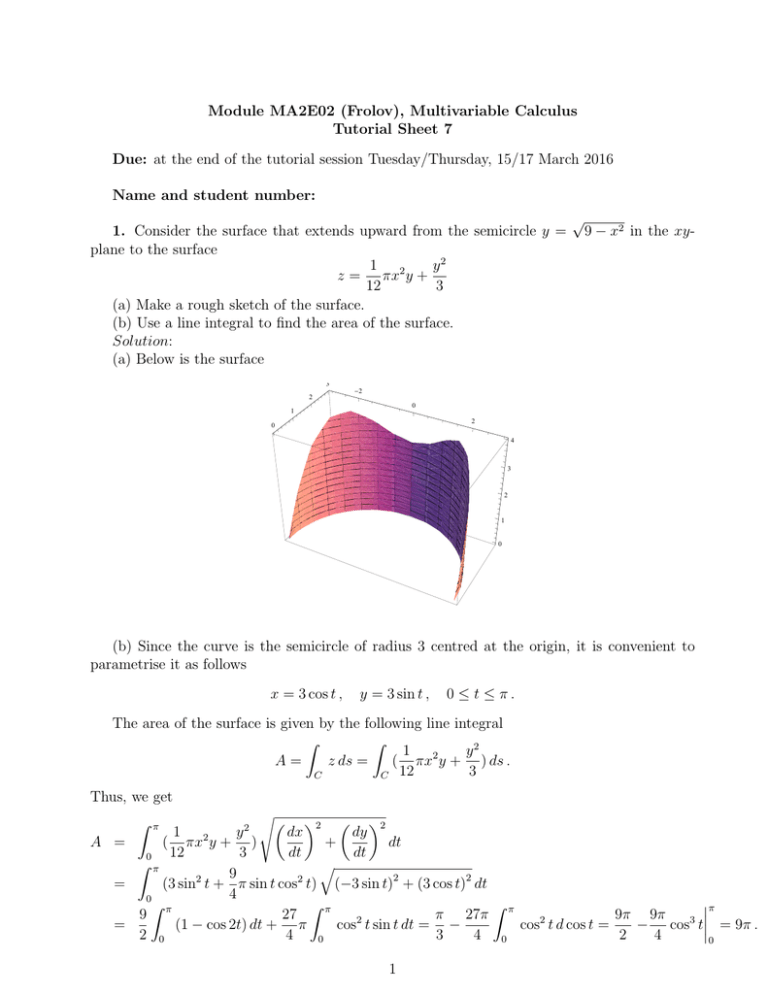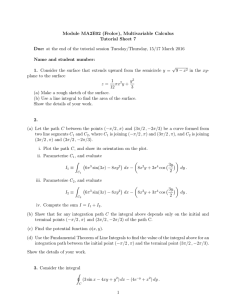Module MA2E02 (Frolov), Multivariable Calculus Tutorial Sheet 7
advertisement

Module MA2E02 (Frolov), Multivariable Calculus Tutorial Sheet 7 Due: at the end of the tutorial session Tuesday/Thursday, 15/17 March 2016 Name and student number: 1. Consider the surface that extends upward from the semicircle y = plane to the surface 1 y2 z = πx2 y + 12 3 (a) Make a rough sketch of the surface. (b) Use a line integral to find the area of the surface. Solution: (a) Below is the surface √ 9 − x2 in the xy- 3 -2 2 0 1 2 0 4 3 2 1 0 (b) Since the curve is the semicircle of radius 3 centred at the origin, it is convenient to parametrise it as follows x = 3 cos t , y = 3 sin t , 0 ≤ t ≤ π. The area of the surface is given by the following line integral Z Z y2 1 A= z ds = ( πx2 y + ) ds . 3 C C 12 Thus, we get s 2 2 dx dy 1 2 y2 A = ( πx y + ) + dt 12 3 dt dt 0 Z π q 9 2 2 = (3 sin t + π sin t cos t) (−3 sin t)2 + (3 cos t)2 dt 4 0 π Z π Z π Z 9 27 π 27π π 9π 9π 2 2 3 = (1 − cos 2t) dt + π cos t sin t dt = − cos t d cos t = − cos t = 9π . 2 0 4 3 4 0 2 4 0 0 Z π 1 2. (a) Let the path C between the points (−π/2 , π) and (3π/2 , −2π/3) be a curve formed from two line segments C1 and C2 , where C1 is joining (−π/2 , π) and (3π/2 , π), and C2 is joining (3π/2 , π) and (3π/2 , −2π/3). i. Plot the path C, and show its orientation on the plot. ii. Parameterise C1 , and evaluate Z 3y 3 2 2 4 dy . I1 ≡ 6π sin(3x) − 8xy dx − 8x y + 3π cos 2 C1 iii. Parameterise C2 , and evaluate Z 3y 2 4 3 2 I2 ≡ 6π sin(3x) − 8xy dx − 8x y + 3π cos dy . 2 C2 iv. Compute the sum I = I1 + I2 . (b) Show that for any integration path C the integral above depends only on the initial and terminal points (−π/2 , π) and (3π/2 , −2π/3) of the path C. (c) Find the potential function φ(x, y). (d) Use the Fundamental Theorem of Line Integrals to find the value of the integral above for an integration path between the initial point (−π/2 , π) and the terminal point (3π/2 , −2π/3). Show the details of your work. Solution: (a) i. Below is the path C. 3 2 1 1 -1 2 3 4 5 -1 -2 (a) ii. The line segments C1 is parametrised as x = t, y = π, −π/2 ≤ t ≤ 3π/2 and one gets Z 3y 3 2 2 4 I1 = 6π sin(3x) − 8xy dx − 8x y + 3π cos dy 2 C1 Z 3π/2 3π/2 (0.1) = 6π 3 sin(3t) − 8tπ 2 dt = −2π 3 cos(3t) − 4t2 π 2 |−π/2 −π/2 = −2π 3 (cos(9π/2) − cos(−3π/2)) − 4π 2 ( 2 9π 2 π 2 − ) = −8π 4 ≈ −779.273 . 4 4 (a) iii. The line segments C2 is parametrised as x = 3π/2, y = t, π ≥ t ≥ −2π/3 and one gets Z 3y 2 4 3 2 I2 = 6π sin(3x) − 8xy dx − 8x y + 3π cos dy 2 C2 Z −2π/3 3t 3t −2π/3 3π 2 4 dt = −9π 2 t2 − 2π 4 sin | = − 8( ) t + 3π cos 2 2 2 π π 2π 3π = −9π 2 ((− )2 − π 2 ) − 2π 4 (sin(−π) − sin ) = 5π 4 − 2π 4 = 3π 4 ≈ 292.227 . 3 2 (0.2) 4 (a) iv. The sum gives I = −5π ≈ −487.045. (b) We have 3y 3 2 2 4 . f (x, y) = 6π sin(3x) − 8xy , g(x, y) = − 8x y + 3π cos 2 Thus ∂y f (x, y) = −16xy , ∂x g(x, y) = −16xy , and therefore the integral is independent of the path. (c) To compute the integral we find the potential function φ(x, y) ∂φ = 6π 3 sin(3x) − 8xy 2 ∂x (3 marks.) ⇒ φ(x, y) = −4x2 y 2 − 2π 3 cos 3x + C(y) . To find C(y) we use that (3 marks.) ∂φ dC(y) 3y 2 2 4 = −8x y + = − 8x y + 3π cos ∂y dy 2 3y +C. ⇒ C(y) = −2π 4 sin 2 ⇒ dC(y) 3y = −3π 4 cos dy 2 (0.3) Thus, we get φ(x, y) = −4x2 y 2 − 2π 3 cos 3x − 2π 4 sin 3y +C. 2 (d) By using the formula, we obtain Z (3π/2 ,−2π/3) 3 6π sin(3x) − 8xy (−π/2 ,π) 2 3y dx − 8x y + 3π cos 2 2 4 which agrees with the result in (a) iv. 3 (3π/2 ,−2π/3) dy = φ(x, y)|(−π/2 ,π) = −5π 4 , 3. Consider the integral I (3 sin x − 4xy + y 2 ) dx − (4e−y + x2 ) dy . C Assume that the curve C is oriented counterclockwise, and it is the boundary of the region R between y = x2 /2 and y = x. (a) Sketch the region R. (b) Use Green’s Theorem to evaluate the integral. Show the details of your work. Solution: (a) Below is the region R 2.0 1.5 1.0 0.5 0.5 1.0 1.5 2.0 (b) By Green’s Theorem we have I ZZ ∂(−4e−y − x2 ) ∂(3 sin x − 4xy + y 2 ) 2 −y 2 (3 sin x − 4xy + y ) dx − (4e + x ) dy = − dA ∂x ∂y C R ZZ Z 2Z x Z 2 x2 x4 2 = (2x − 2y) dA = (2x − 2y) dy dx = 2x(x − ) − (x − ) dx 2 4 R 0 x2 /2 0 2 1 1 1 8 8 4 = ( x3 − x4 + x5 ) = − 4 + = . 3 4 20 3 5 15 0 4





